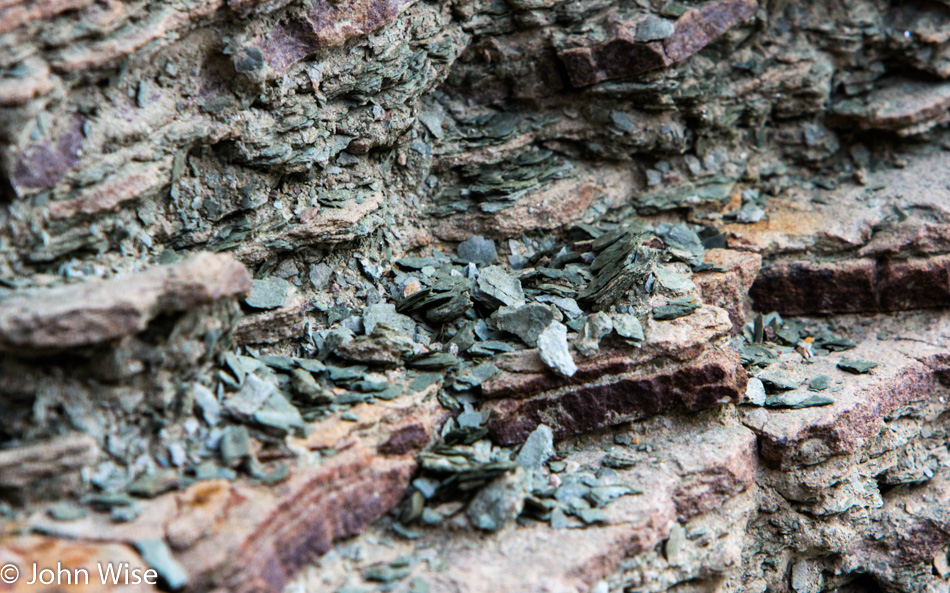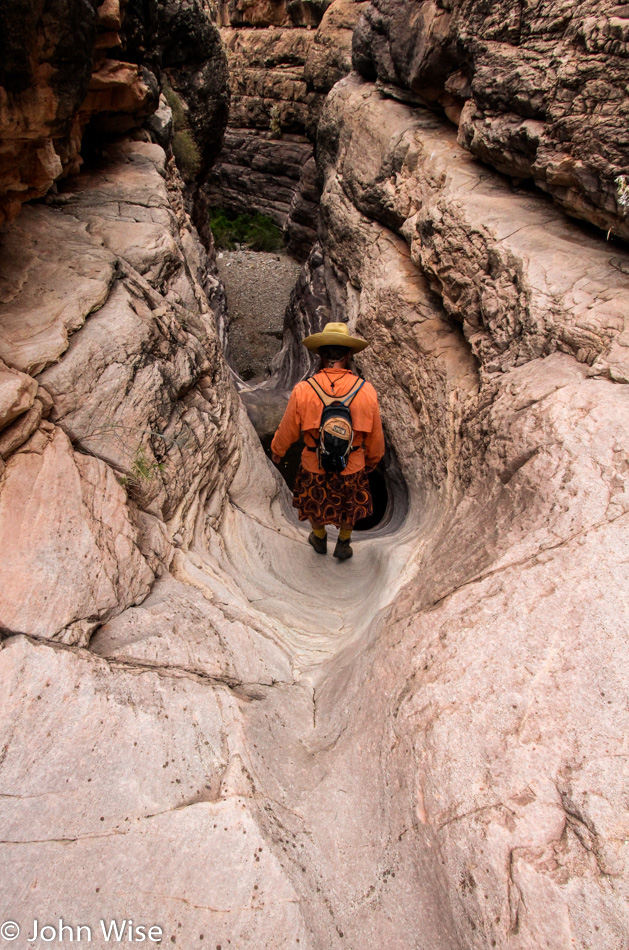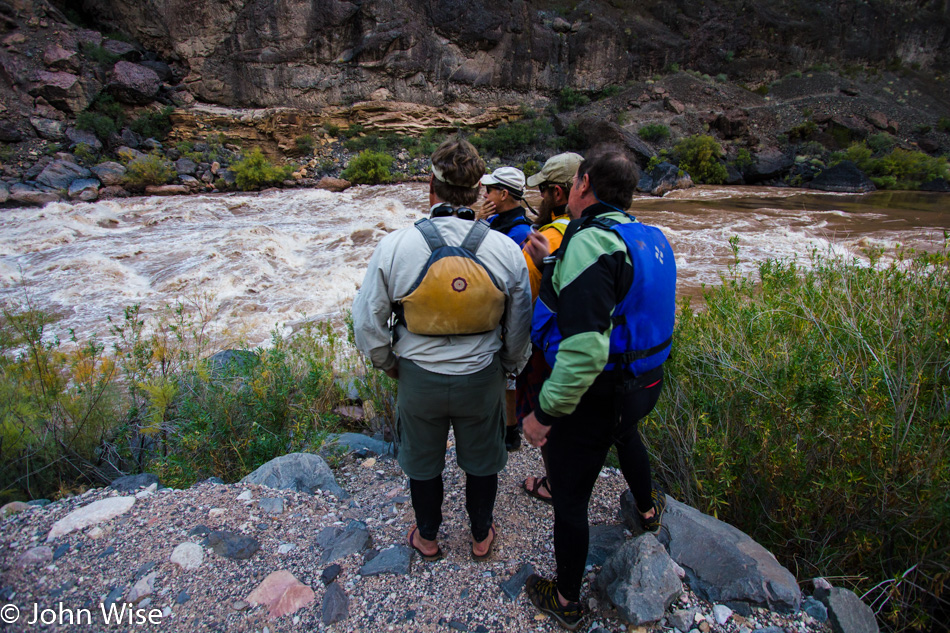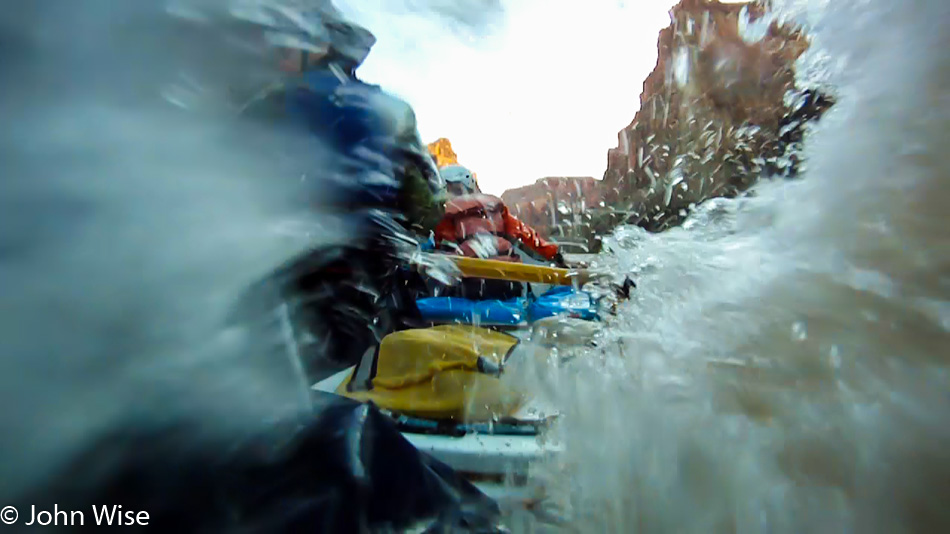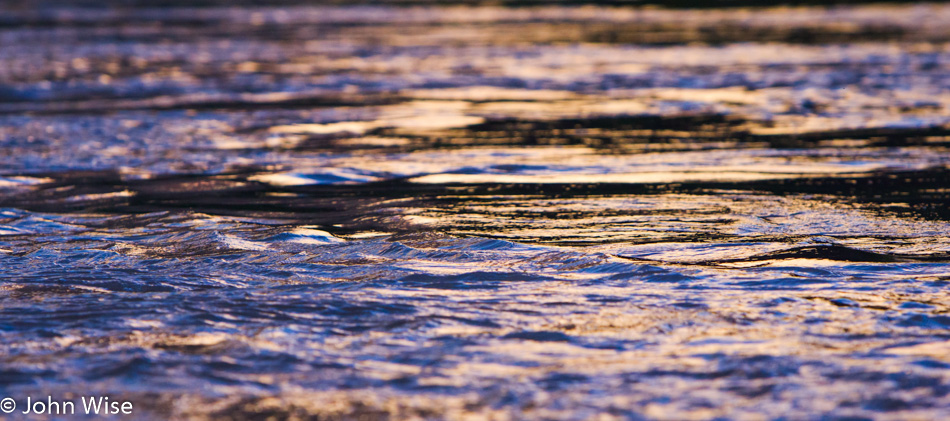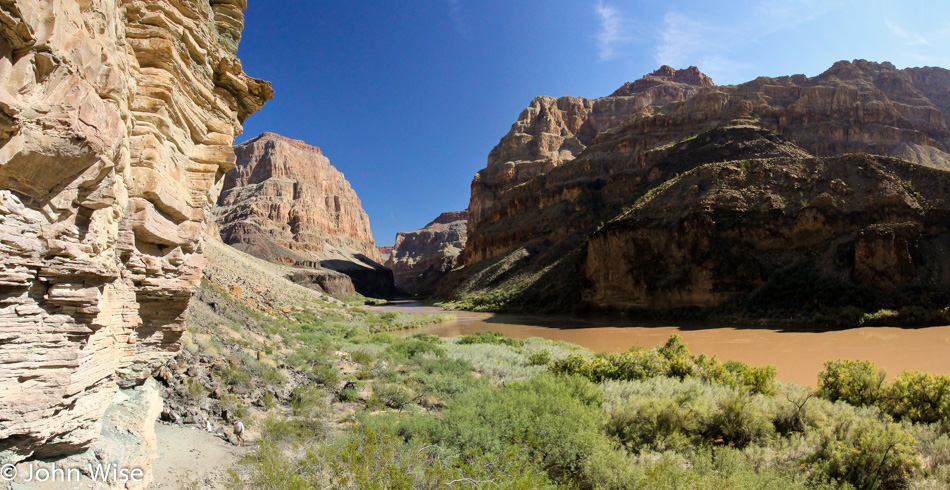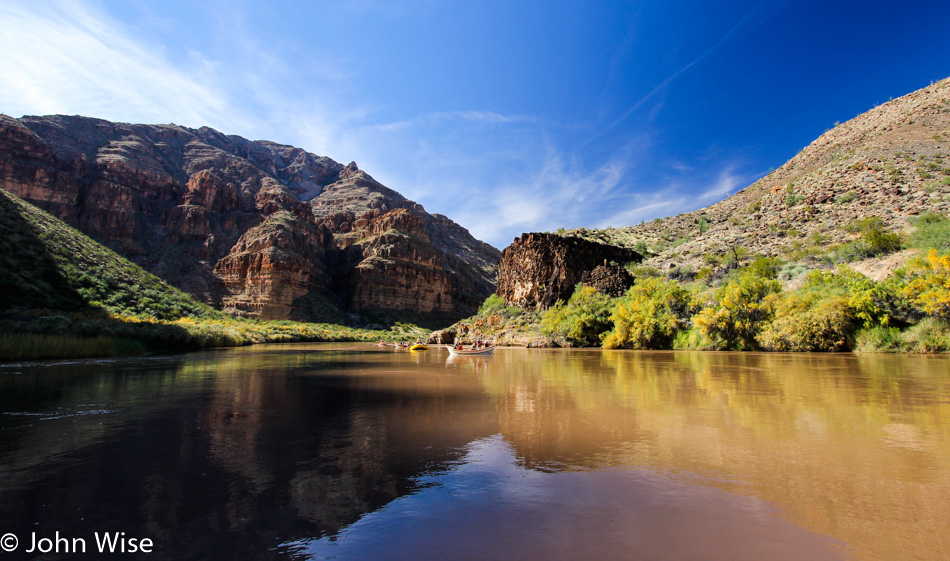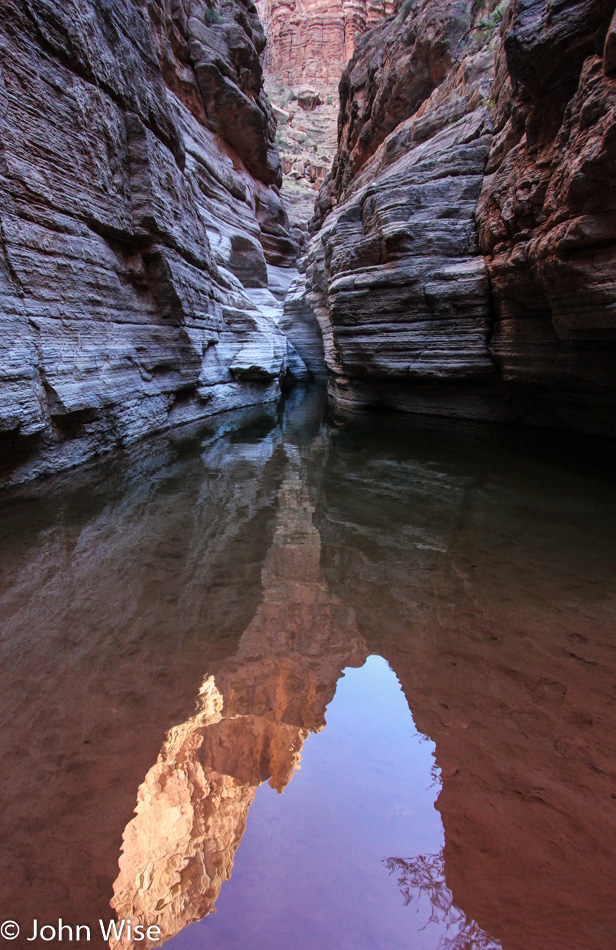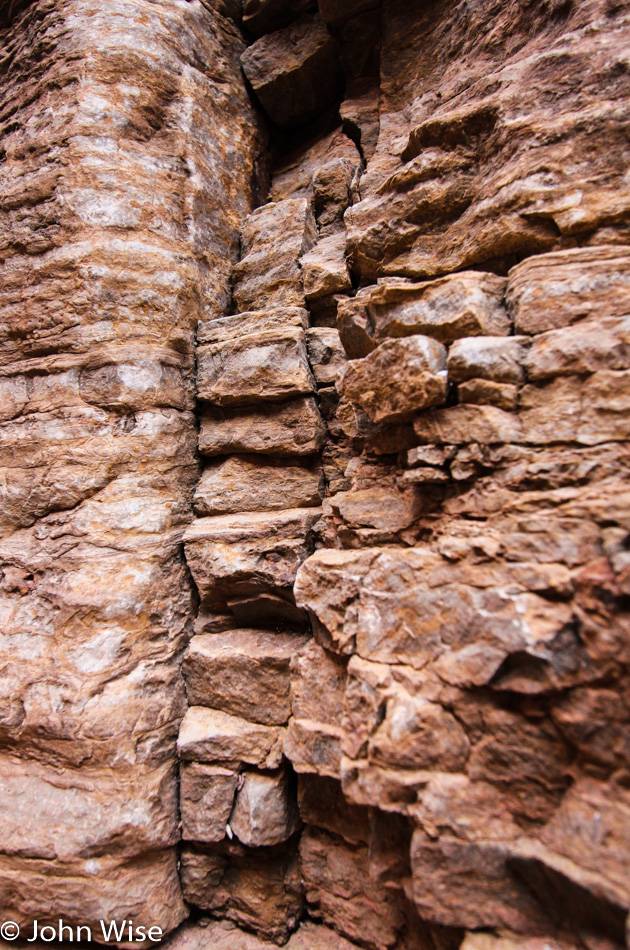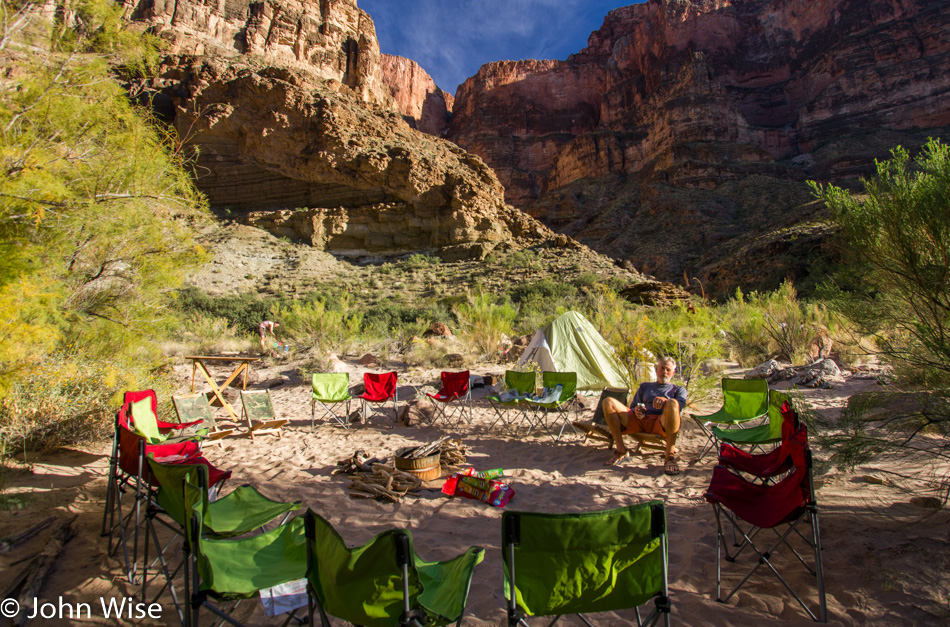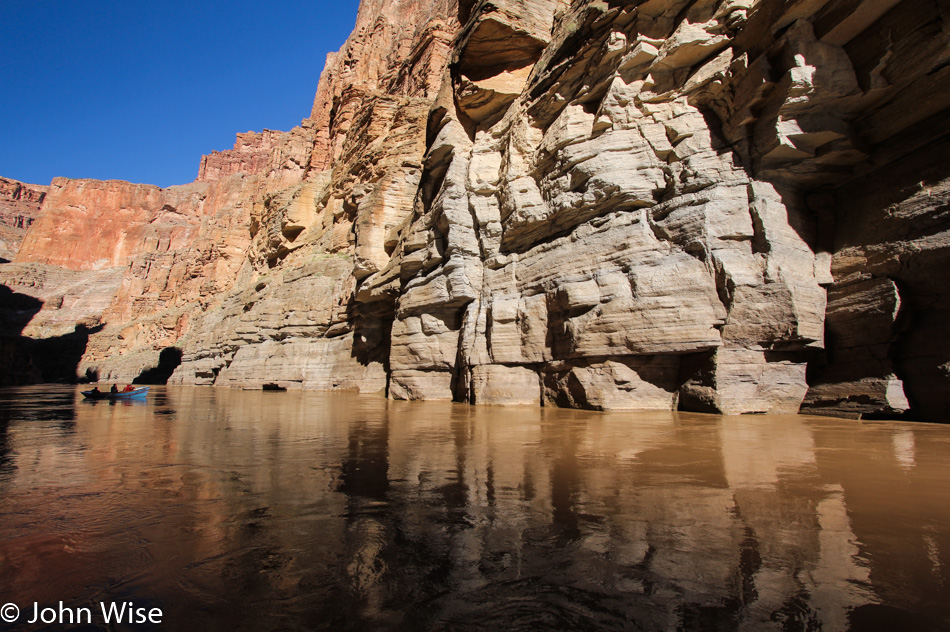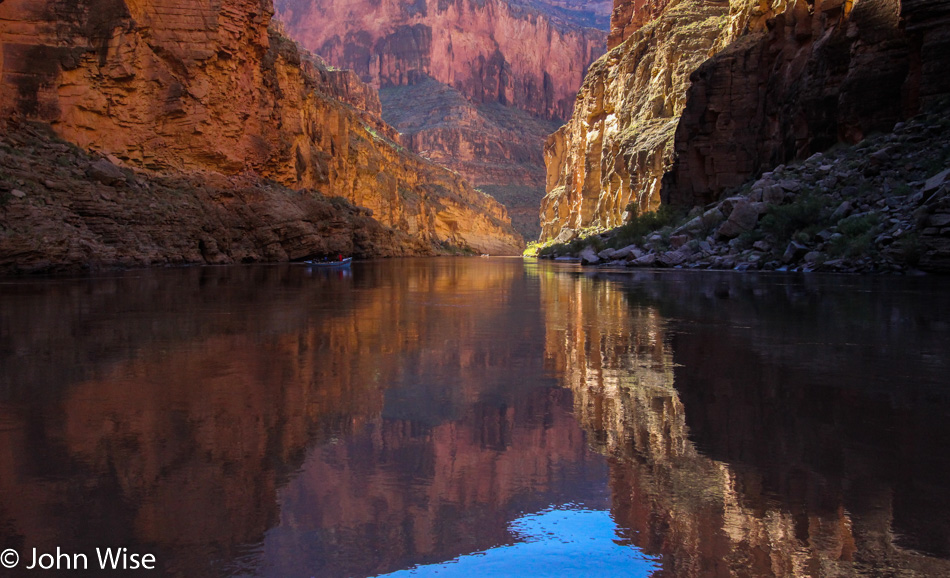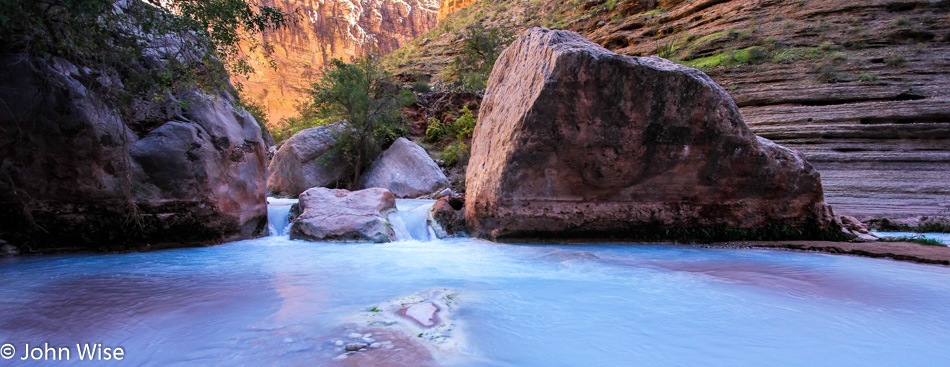
We wake late to a 6:30 call telling us, “Coffee’s ready!” After breakfast is done, the gear and bags are packed and loaded, we are ready to go. We’ve been promised a relaxed day, bah humbug. I want intensity, fervor, and another 100 miles tacked on. I’m willing to sacrifice the return home and a hot shower. Instead, we will row downriver toward the exit. Goodbye, mile 209 and Granite Park. Good morning, river.
Here we are once again on the Sam McGee with Jeffe. Caroline and I are upfront, First Light Frank and Sarge in back. There are a few small rapids we’ll maneuver, but nothing of any consequence. The helmets are stowed and won’t be out again. Mile 210 is overtaken as we continue in the quiet of the early day. There’s nothing much to be said between us that hasn’t already been said, or is it the weight of what we are rowing towards that is bearing down on the conversation?
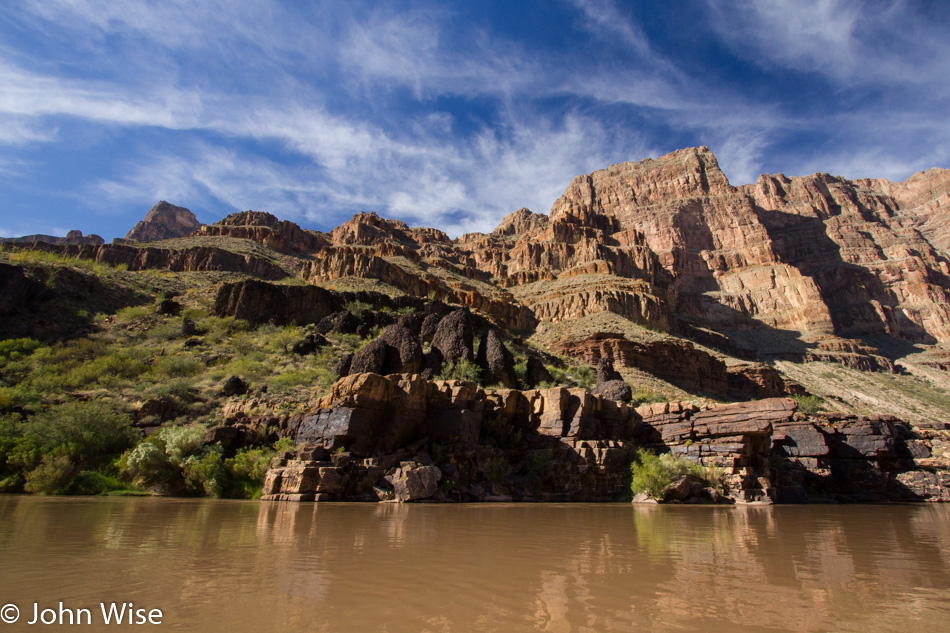
What would all of this have been without the boatmen? The short answer would have been a group of people prone to stumble into the occasional mistake that easily could have spelled disaster on a whitewater rafting trip.
What was our trip with professional boatmen on a commercial trip like? A group of strangers came together, becoming a family of close-knit explorers on a journey into fascination. We, lucky travelers, basked in luxury, thanks to the boatmen who made extraordinary efforts to guarantee our safety, showed us a path into the amazing, and fostered a healthy sense of wonderment.
When pushing off at mile zero, one embarks on what will end up for many to be the most memorable trip of their lifetime, regardless of how far they may have traveled the globe. Bring your friends, your family, and people who need to open their eyes to possibilities not yet imagined, but remember that this trip is about more than just spending time with your loved ones. We are also here to grow our memories, learn new stories, and if we are lucky; we will explore the depths of who we are. To some extent, we already know our friends and family; we know many of their stories, but do they truly know the Canyon? The boatman does. They are the table of contents, the forward, and the epilogue to the story. They are the icing, the sprinkles, and the candle that decorate this layer cake of history we slice through.
The boatmen are uniquely different from our own personalities. We are not best friends with them on day one. These people at the oars possess their own set of abilities through their various strengths, curiosities, and quirks of personality. When brought together to guide a river trip, their love of the Canyon and tremendous experience in this environment are what allows them to bring a diverse mix of travelers together to work in concert as a cohesive group.

On the days after our boatmen first greeted us, we would gradually get to know Bruce, Jeffe, Rondo, and Kenney – even growing fond of them the more we learned from and of them. On the day we will say goodbye, much water will have passed under our boats, and our sense of family will have been extended. During these weeks, we shared in their enthusiasm, learned from their experiences, delighted in their song, and reveled in their stories.
It is, in part, their story that greatly enriches one’s time here at the bottom of the Grand Canyon. On this river alone, our four boatmen have collectively made 357 descents on the Colorado, totaling more than 80,000 miles. The arms and backs of these people at the oars have rowed the equivalent of more than three circumnavigations around our planet. What stories and experiences would any of us have in our possession with this accumulation of time invested in getting to know a 225-mile-long corridor cut through the surface of the Colorado Plateau?
If the river is what ties boatmen together and collected river miles are the lessons that foster expertise, it is their individuality, combined with the wisdom of those who mentored them, that has given shape to the modern boatman. These are the people of stout nature who have succeeded in the oar strokes of the proto-boatmen found in J.W. Powell’s crew, Martin Litton, and other pioneers of adventure. They are keeping alive the spirit of their fellow river legends, too numerous to mention, who have been traveling these waters for nearly 150 years. What we can learn from this long history of river guides is that they have inherited a legacy that does not rely upon artifice, illusion, or deception. When on the wilds of the Colorado River, these boatmen operate with the intuitive skills given them by those who came before them. They happily shine a light upon the library of knowledge they dip into for sculpting our experience of the Canyon.
Here in the southwest, a rich heritage of Native American history can still be found; we are living on their ancestral lands and find evidence of their long presence throughout these states. It is through this filter I see these men of the oars. Out of the four sacred directions, our boatmen are brought in, each with their own path, each on their own flow of the wind.

Boatman Stephen Winston Kenney
On the east wind, representing birth and newness, is Stephen Kenney, a compassionate man who is the junior boatman on this trip; he shows respect to his elders, knowing he has much to learn from their old hands. From the south wind comes adolescence in the shape of Rondo Buecheler. This boatman is the perpetual adolescent, a deity of festivity, wine, and party – in all its 1970s raging river fun. Next up, we encounter the west; with it comes adulthood and Jeffe Aronson. This man is the observant and patient parent, tending to his children while trying to teach them some of the important lessons of life. Finally, hailing out of the north, the wind gives us Bruce Keller, the man of wisdom. His quiet knowledge allows him to stand in the background and, when necessary, offer the tribe a nudge that will set us on our path to finding the sage within.

Boatman Bruce Keller

Boatman Jeffe Aronson

Boatman Rondo Buecheler
Now bring together the four cardinal directions, the four winds, the four boatmen. Bring together the river experience they have earned, the time they have dedicated to exploring this Canyon, the compassion, insight, humor, and expertise, and tie this to the work of moving dories, passengers, food, and everything else that will sustain and carry our flotilla during these days. With all of this, you have the elements that turn a river trip into something that is much more than the component parts it is built from. The layers of experience begin to stack up like so much sediment that collected over millennia to build the Colorado Plateau; the boatmen are the tools that are instrumental in the carving of our personal Grand Canyon of memories.

Parents give us life and all of the potential that will carry us into an unknown future of being our own person. Our teachers offer us the skills to define and interpret our environment that may help us survive a world driven by economic realities. Personal growth shouldn’t stop there. It is a tragedy to fall into a routine until reaching retirement, hoping then to reignite a rusty imagination to explore and learn again. Where is the parent, mentor, or figurative boatman who can guide us through our adult years when we might find ourselves drifting oar-less down the river of life? Will we even have open ears and minds to know the value of shared wisdom when we have been taught to see independence and autonomy as the only ways to be free? Wouldn’t we benefit from truly being a community? Why do we not inspire each other to take a seat at the helm and row ourselves into a new future, as our elders did for us when we were children? Are we so well equipped with the knowledge of life in this ever more complex world that we can really go it alone?
How did we become so self-assured and all-knowing on the day when we transitioned from childhood to being an adult, only to enter a holding pattern instead of continuing to explore the big unknowns? How do we chip through the thick skin of modern life and ego to find our inquisitive mind? How do we keep growing?
We find mentors and those special people who can take us on journeys into life, nature, and, in turn, ourselves. Hold on, as once you make this commitment to your own well-being, the river of life and the rapids of experience have much to show you on their bumpy ride. Remember that your travels and learning are never complete; you should strive to explore the story of what is missing from your evolving narrative. The end of our personal book is only found on the last page, and that last page won’t be written until our last day. Take time to find the adventure and inspiration that takes you into your own story of magic.
Hello, mile 211. Don’t mind us; we’re just passing through on our way to your neighbor, mile 212. A mild bump in the flow here and there reminds us of the previous days when wild rapids threatened to upset our intentions to pass over the rage and exit in the calm. Today is so tranquil it could be considered serene. I can’t really complain, though; if someone were to mount a Spirit of Ecstasy on the bow, I could easily believe we were traveling by the Rolls Royce of boats on a glassy highway. This very embodiment of elegance delivers us to mile 213.

Then, out of the silence, Jeffe gives us the opportunity to jump into the river and ride a rapid while floating downstream. Instead of inspiring Caroline or me, this offer speaks to our timidity, bringing about our only regret on this trip. We don’t accept his offer, but Sarge does – lucky guy. We are given plenty of notice to psych ourselves up and enough time to change our minds, but we can’t muster the courage. On the approach to mile 215, Sarge takes off his shirt and puts his life jacket back on. Then, with a yell of “SEMPER FI,” he leaps from the dory and cannonballs into the river for a ride through the rapid, floating on his back. We could have been there right next to him.
It must have been that Marine training or the steeled nerves from working as a State Trooper, maybe it was an intense love for where he finds himself. Whatever it was, even in retirement, this man’s display of fortitude, jumping right into the cold waters of the Colorado, put me to shame. His example will always remind me not to pass up an opportunity that may never again present itself.
Jeffe turns the oars over to First Light Frank, who typically is found sitting atop our dry bags on a raft. Frank brings the dory around so Jeffe can help Sarge out of the frigid water and back into the boat to warm up in the sun. I wonder if Sarge had watched someone else jump in years ago, on a previous trip down the Colorado, and had similar thoughts of regret as I am now having. Getting back on board, he tells us how he hadn’t done the swim on his other trip and just had to make it happen this time.
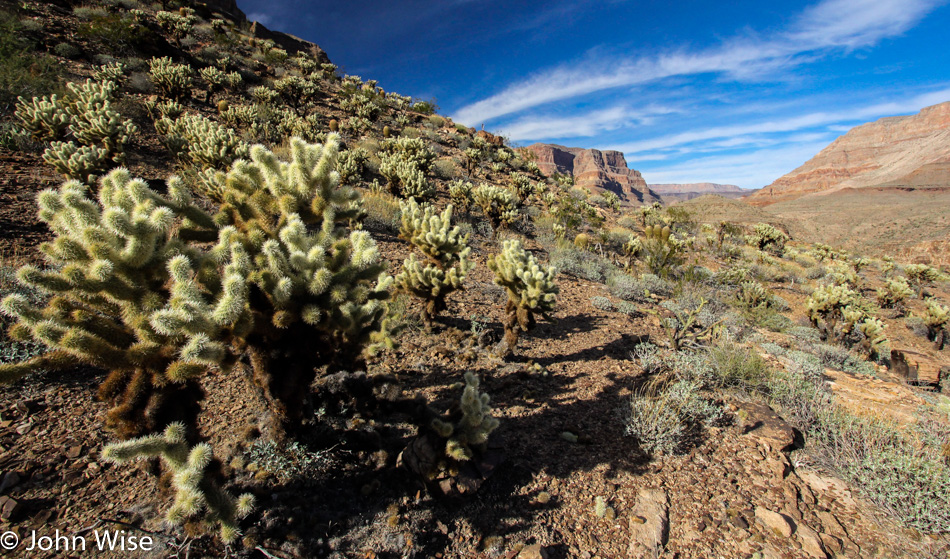
Before we know it, mile 216 is moving into the distant memory closet. Mile 217 holds another small rapid and the opportunity for Caroline to crawl up on the bow of the Sam McGee to claim victory that she has taken bow rides on all four dories. She’ll have long ago left the bow when miles 218 and 219 are sailed through. At mile 220, we ready our approach. Like the space shuttle Atlantis connecting to the space station on its final flight, we will make a long, dramatic docking with shore, worth every cent we can earn from the experience. Tomorrow, when we disconnect from camp for our return to Earth, Mission Control will sign out, and the dories will retire for the season.
But the show is not over yet; I’m the fat bearded man, and I’m not yet ready to sing. Following lunch, we depart for one more hike, this time into the teddy bear cholla forest above our camp at mile 221. While heading out I have to ask, “Who turned on the heater?” It is 88 scorching degrees – in November! No matter, intrepid and stout of heart, we can scale escarpments like pedestrians negotiating a busy mid-town sidewalk. Show us your fangs, thorns, broken trails, and cragged surfaces; we have tackled more and haven’t fatigued yet. With all the enthusiasm we entered Soap Creek Canyon with back on day 1, we are now climbing a mountain for one more look up and down this majestic living river.
Gazing upon the Colorado, I see the tears that fell upstream days ago, racing with the current to rejoin the eyes they fell from. We are safe up here; those tears will never make it up the trail we just clambered over. Plus, we have the sun on our side threatening to evaporate any eye moisture, planning on making an appearance this afternoon.
Downriver, less than 6 miles from here, the exit signs are already illuminated with flashing yellow caution lights, signaling us to prepare to merge. I shield my eyes. Those lights are phantasms, and even if they were real, they do not pertain to me. I shift my vision left, as Diamond Peak is pointed out. Oh no, if that is, in fact, Diamond Peak, then behind that must be Diamond Creek, and if that is what I’m starting to believe it is, then, off in the distance, I may be looking right at mile 225.9 or thereabouts. I can feel the tug of the vortex that will soon pick up speed in order to yank me from this perfect sense of being. I quickly look away, but some of those lost tears must have made it ashore, likely stowed away in someone’s water bottle, and have now reached me up here on the burning slope.
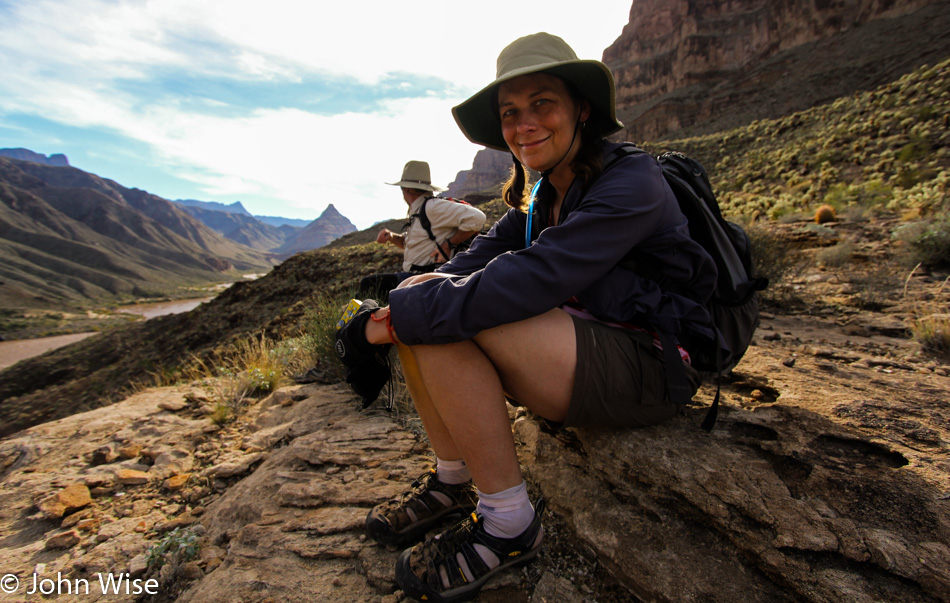
Not able to run from these emotions, I sit down, look out, and consider what has been accomplished. I am grateful, I am overwhelmed, and I am changed. I am not the same person I was when I entered this Canyon. Out of the abyss, no monsters will follow me home. I am more centered and more unified than at any other time in my life. Okay, I suppose I’m ready to be ejected. I reach for Caroline’s hand, and slowly, together, we return to the river’s edge.
Back in camp, Rondo has unloaded the remaining alcohol. Beer, absinthe, tequila, and everything else that had been nearly lost in the darkest corners of the dories are made available. What is not consumed must be packed out, and upon reaching the pull-out, things must move fast to make room for the next group taking out. The lighter the load, the quicker we are underway. So drink up, eat to your heart’s content, and get ready for No Talent / Talent Night.
Liquid courage to the rescue. Stage fright easily falls away as a sip of this and a sip of that inebriates the crowd. Caroline will be the first performer to display her amateur No Talent / Talent skills, as hers is a recital that must precede a meal. A couple of years ago, my wife became intrigued by the Sanskrit prayer offered by our Gujarati friends when sitting down to eat. Caroline’s idea was to secretly learn the entire prayer by heart and then surprise our friends on a random night when she would join in the recital. When that evening came around, she nervously joined in, her words merging with theirs. I watched each of those ladies open their eyes to confirm what they thought their ears were hearing. Tears flowed down their cheeks, and smiles graced their faces as they watched my wife, who, with eyes closed in concentration, finished the prayer with them.
Geologist Clarence Dutton was apparently also inspired by Indian culture. It was his awareness of the Hindu trinity of Brahma, the creator – Vishnu, the maintainer – Shiva, the destroyer, that would influence his choices back in 1882 while naming some of these towering Canyon spires. Caroline felt it was appropriate to give thanks and ask for blessings in the tongue of these Hindu deities, who likely had never heard these ancient words from below the peaks that bear their names. Tonight, I was brought close to tears from Caroline’s recital, feeling overwhelmed by her sensitivity to other cultures and the joy I feel in knowing her as my best friend for 21 years.
After a supper of barbecue pork loin, baked potato, candied carrots, green beans with mushroom and onion, avocado & tomato salad with garlic, applesauce, and a fresh-baked dessert of chocolate cake with chocolate frosting, our procession of potential No Talents is ready to take the stage and prove that we are all in possession of at least a small amount of talent. It may not be polished or well-practiced, but it will be offered up with honesty and conviction as we try our best.
Next up is the passenger hailing from the great state of Hawaii, Jakki Nelson. Jakki demonstrates her musical talents, playing guitar and singing us a song. Finishing her performance, she nods a bow to the applause that fills the air.
Jerry Hamilton from Washington tells us a story about a novice hunter and an insightful bear whose encounters with one another proved more painful for the man stalking the bear than the other way around. Laughter erupts. Jeffe steps in with another bear story to add to the moment of hilarity.
Then the lights dim, and a spotlight comes up on Sarge, who has appeared out of the dark dressed as a princess, reviving his costume from Halloween. The now bizarre illusion of femininity in the shape of the former Marine / State Trooper ups the ante of laughter as he slithers into the lap of a boatman with a fantastic impersonation of Marilyn Monroe in an oddly lumpy dress. The hoarse princess tells us, and the boatmen, of her admiration, just how much she loves and appreciates them – this got steamy, I tell ya. I feel sorry for whoever tries to follow this and then make a note to send Sarge’s wife the incriminating evidence.
Boatman Ashley sacrifices herself on the feisty crowd that has been warmed up now, offering us a poem about reincarnation. Sorry, but I cannot recall a word of her No Talent / Talents; it will forever be overshadowed by the story she told us earlier in the trip, which involved an Englishman with his thumb up the bum of the largest Bengal tiger in all India.
Up next, Erin, Jerry’s wife, gifts us one of the greatest treasures collected from our days in the Canyon. Turns out that throughout the trip, Erin had been noting the quotes and sounds that would help remind us of much that was heard here in the Canyon. We listen intently as Erin reads from her list, recognizing how ingrained some of these sound bytes have become. Reveling in the fleeting moments, we ponder the heartfelt inspirations of thoughtfulness shared on our journey.
Boatman Andrea and her mom Linda stand up to flaunt their talents and what talents they have. First, you must bring the tune from On Top Of Old Smokey into your head and then sing the following out loud, with gusto:
On top of a big raft
That carries the shit
Is where my poor mother
Is forced to sit!
She sits in the front
and sometimes in back.
She holds on for dear life
when the waves come attack!
We float down the river
to camp, then we dine.
That’s when my dear mother
wants a full cup of wine!
I give her a little;
she asks for some more,
but then my sweet mother
can’t find the tent door!
Hot coffee in the morning
is her first delight
She won’t move a muscle
‘til Frank shouts “First Light!”
When cooks are in the kitchen
the guides are drinking beer.
They tell stories and jokes
I wish my mom couldn’t hear!
My mom is super
My mom is sweet.
Bringing her down ‘the big ditch’
has been quite a treat!
WAIT!
The song is not over.
We wrote a new verse the other day.
It was Lava Falls morning,
when I swam away!!
Super Mom yelled “Get back here,
this is a fight you can’t win!”
She grabbed for the oars
and pulled my sorry butt in!
Those of us nervous orators should have gotten our potentially weak acts out of the way earlier. What is being delivered here at the No Talent / Talent Night is measuring up to be full of talent. I begin to shrink under the pressure.
Joe brings his voice to work for our listening pleasure with a song about Lava Falls set to the tune of “Wild Mountain Thyme.” Throughout our days together, Joe had sung many a time. In addition to the beautiful hymns he shared with us in Blacktail Canyon, he serenaded us one morning before launch with Jakki singing harmony. We delighted in their very own rendition of “Oh, What A Beautiful Morning.” On other days, Joe would offer us a reading from his notebook of observations. Joe is certainly a devout man of many talents.
Boatman Katrina executes a double-jointed body trick that is met with mouths gaping in disbelief and bugged-out eyes. She clasps her hands together and moves her torso through this loop twice. At this point, a few of the drinkers are probably wondering if they had one too many and if the pink elephants are on their way.
Yours truly picked up the next spot reading an homage I had been crafting since early in the trip, titled:
“How Can One Thank A Boatman?”
You are guides, teachers, storytellers, great cooks, caregivers, bringers of adventure, and a hand when needed. You are life changers, mentors, the knowledgeable ones who brought us back to the tribe. You are river shamans.
You gave us fire, water, earth, and sky. With you, we needed nothing but open eyes, a willingness to participate, and an open heart. You gave it your all.
It is not lost on us how, against the forces of nature, including the sand, river, and wind that cut this Grand Canyon, your backs, hearts, and spirit-guided dories, rafts, passengers, and beer with deft precision and expert skill.
But your task is not simply to supply entertainment to a few lucky souls on this grand adventure. Your gift to us is the sharing of your passion, wisdom, and insight, allowing us to witness this magnificence in ways undreamt of 17 days ago when we were putting in at Lees Ferry.
You alter our imagination, help form profound memories, and better our person. You are changing the lives of your charges like the sand, water, and wind that shape this world that is your second home.
Hugs, handshakes, a shared meal, or a drink can never give enough thanks for how you eroded the calluses of modern life from our hearts and invited us into yours. I can only thank you and let you know that today, I am rich in experience beyond belief because of the boatmen of the Grand Canyon.
Because of all of you, this mighty river will always flow with me. The towering canyons will always stand high above me. Your songs and stories will echo into my future. And your love of your work, your world, what you do, and who each of you are will course through my life like this Colorado River running through the Grand Canyon.
While anyone who knows me will tell you that I can talk, talk, talk some more, and maybe even dominate the conversation, I must admit that public speaking sends butterflies to my midsection. Tonight was no different, but in practicing what I preach, I felt I had no option other than participating. My worst fear was about where my emotions would take me. As I practiced reading my note of gratitude, I found myself close to the water, with the pool of tears maintaining a vigil by my side – so impassioned were my feelings for what I was going to read. A quivering voice, fighting off the impulse to read faster, and with my ears on fire, I got through this – my own personal class 8 rapid.
Physics professor Charlie is handed the proverbial baton and begins to talk about the universe and the stars in the night sky, how there are billions of stars in our galaxy alone, when his wife Mari interrupts what could easily have veered into the overly technical and tells us that they had rehearsed a more lighthearted show of talent. They could hang spoons from their noses. And that is exactly what they did, to our delight.
Quiet, traveling by himself, a man of few words, Phil keeps us guessing as he ‘warms up’ with uncomfortable-looking gulps of air. He explains that he isn’t sure how this will work out, as he hasn’t performed this since his college days. His preparation looks convulsive, and then it begins. Maybe it’s a song, although it could be a poem being presented in a kind of Morse code. Whatever it is, it is definitely the longest sequence of burps any of us will ever hear. I do believe that Phil has offered the strangest displays of No Talent / Talent we are likely to see this evening.
Paul offers us a poem, with the help of Ellen reading the second character’s parts. But it was Ellen’s segue and request to have the brochure rewritten that was the most memorable part of their performance. She made humorous observations about the demands placed on passengers that the brochure did not mention, such as bailing dories that are filled to the rim with ice water. Also glossed over was that we would be pitching tents as though we all knew how. Were outdoor riverside toilets talked about in the literature? She didn’t think so.
Mike Boyles from Oklahoma sings a bawdy song that, even if I had the naughty lyrics, they wouldn’t have found space to be reprinted here without an R rating.
And that is the extent of the passengers’ participation in the No Talent / Talent Night. But it isn’t the end of the storytelling. Bruce takes the floor with a story about a stomach-churning accident with one of the Units. Rondo offers a great tale of his encounter with Secret Service agents during a visit to the river by President Jimmy Carter and a mishap that occurred. Want to know more about this incident? Better find yourself booked on a trip with Rondo before he retires.
Kenney reads another one of his poems, this one about the Ghost Trees. Should you meet him someday on a river, ask him to tell you about the fire he witnessed on the Middle Fork of the Salmon River in Idaho. Ashley, Bruce, and Rondo, as an encore, each tell us a personal story about their mentor, Martin Litton. It should be noted that back in 1955, less than 200 people had run this river. It would be during that year that Litton would have his first encounter on the river within these walls of the Grand Canyon. With that run, he became the 185th person following Powell to have done so. Martin was inspired to work in collaboration with another river pioneer, P.T. ”Pat” Reilly, to modify the dory’s design in an attempt to popularize this mode of travel on the Colorado. By 1962, these two Canyon enthusiasts finalized a blueprint for what would be a four-passenger craft with a boatman at the center. Soon after this achievement, Grand Canyon Dories was born. From our boatmen, there is no lack of love and respect shown to Martin Litton; he is a giant here in the Canyon.
Katrina closes the show with a performance of two a cappella songs. For a night that was supposed to be short on talent, it is wonderful that not one person held back, and all rose to the occasion to offer one another a glimpse into their sense of silliness or the serious.
Caroline and I spend our final night sans tent. The tarp is spread out, sleeping pads put down, and sleeping bags unrolled. Laying there, we look up to the stars, smell the cool night air, listen to the murmur of the river, and with a heavy heart, we acknowledge the sadness that these sights, these nights and days, are about to be over. A hug, a kiss, one more nod in recognition of our shared love; it is time to sleep and not dwell on what our next steps will be. Tomorrow, we will wake, have a coffee, and take our place on a dory that is heading down Colorado, looking for the next adventure.
–From my book titled: Stay In The Magic – A Voyage Into The Beauty Of The Grand Canyon about our journey down Colorado back in late 2010.





